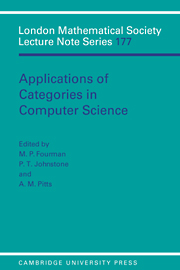 Applications of Categories in Computer Science
Applications of Categories in Computer Science Book contents
- Frontmatter
- Contents
- Preface
- Miscellaneous Frontmatter
- Computational comonads and intensional semantics
- Weakly distributive categories
- Sequentiality and full abstraction
- Remarks on algebraically compact categories
- Dinaturality for free
- Simply typed and untyped lambda calculus revisited
- Modelling reduction in confluent categories
- On clubs and data-type constructors
- Penrose diagrams and 2-dimensional rewriting
- Strong monads, algebras and fixed points
- Semantics of local variables
- Using fibrations to understand subtypes
- Reasoning about sequential functions via logical relations
- I-categories and duality
- Geometric theories and databases
- Partial products, bagdomains and hyperlocal toposes
Reasoning about sequential functions via logical relations
Published online by Cambridge University Press: 24 September 2009
- Frontmatter
- Contents
- Preface
- Miscellaneous Frontmatter
- Computational comonads and intensional semantics
- Weakly distributive categories
- Sequentiality and full abstraction
- Remarks on algebraically compact categories
- Dinaturality for free
- Simply typed and untyped lambda calculus revisited
- Modelling reduction in confluent categories
- On clubs and data-type constructors
- Penrose diagrams and 2-dimensional rewriting
- Strong monads, algebras and fixed points
- Semantics of local variables
- Using fibrations to understand subtypes
- Reasoning about sequential functions via logical relations
- I-categories and duality
- Geometric theories and databases
- Partial products, bagdomains and hyperlocal toposes
Summary
Introduction
In his seminal paper [Plo77], Plotkin introduced the functional language PCF (‘programming language for computable functions’) together with the standard denotational model of cpo's and continuous functions. He proved that this model is computationally adequate for PCF, but not fully abstract.
In order to obtain full abstraction he extended PCF by a parallel conditional operator. The problem with this operator is, that it changes the nature of the language. All computations in the original language PCF can be executed sequentially, but the new operator requires expressions to be evaluated in parallel.
Here we address the problem of full abstraction for the original sequential language PCF, i. e. instead of extending the language we try to improve the model. Our approach is to cut down the standard model with the aid of certain logical relations, which we call sequentiality relations. We give a semantic characterization of these relations and illustrate how they can be used to reason about sequential (i. e. PCF-definable) functions. Finally we prove that this style of reasoning is ‘complete’ for proving observational congruences between closed PCF-expressions of order ≤ 3. Technically, this completeness can be expressed as a full abstraction result for the sublanguage which consists of these expressions.
Sequential PCF
In [Plo77], PCF is defined as a simply typed λ-calculus over the ground types ι (of integers) and o (of Booleans).
- Type
- Chapter
- Information
- Applications of Categories in Computer ScienceProceedings of the London Mathematical Society Symposium, Durham 1991, pp. 258 - 269Publisher: Cambridge University PressPrint publication year: 1992
- 15
- Cited by


